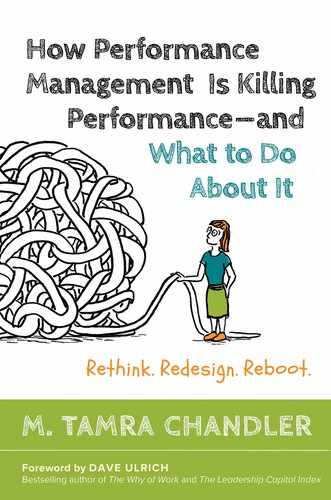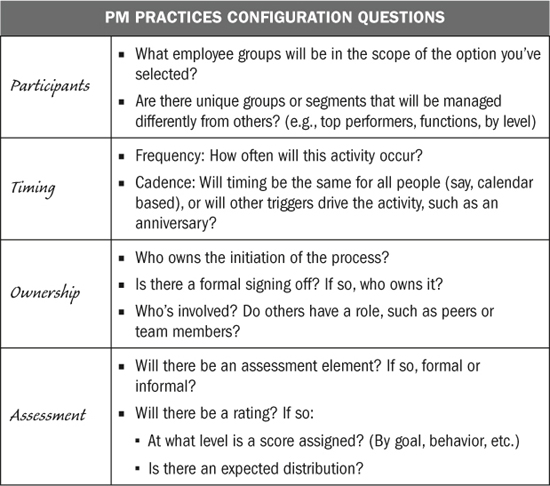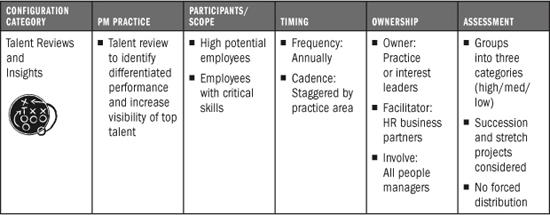Chapter 7
CONFIGURE YOUR SOLUTION

OK, SO YOUR TEAM HAS AGREED to your design principles and you’re ready to roll. This means we now leave Sketch and shift into the Configure phase. Why “Configure”? Because this stage is all about selecting the practices, options, and features that will best match your design principles and bring your solution to life. Yep, we’re finally choosing plumbing fixtures and cabinet door styles!
When configuring, you’ll define a portfolio of PM Practices that together will make up your complete solution. PM Practices are tangible methods, practices, tools, and activities that together create your unique approach to driving organizational performance, developing people, and rewarding equitably in a manner consistent with your design principles. The list of potential PM Practices is long, but a few examples might include setting quarterly goals tied to a defined rewards model, creating development plans, or introducing a formal mentoring program. Some of these PM Practices may be new, meaning that you’ll be introducing them to the organization. Others may be practices that are already in use, which you decide to keep because they work well and because they support your design principles. During configuration we will also define the attributes that establish “who,” “when,” and “how” for each PM Practice. So if you happen to choose formal mentoring as a desired future PM Practice, during configuration you’ll define who will participate in the mentoring, when mentoring activities are expected to occur, and how people will engage in the mentoring process.
Configuration is where you take all of the exploration, learnings, thinking, ideas, and design discussions that have come from your early work and apply that knowledge and insight to creating your future performance solution. You’ll start this phase by simply brainstorming PM Practices and selecting those that best meet your needs. Then, before you dig into configuring each of the PM Practices, you’ll quickly confirm that you’re on track against your design principles and that you haven’t missed any important practices. Once you’re confident in your selections, you’ll define each practice in more detail to understand how each will work when implemented. Before leaving configuration, you’ll test your design to see how you did against your design principles and the Three Common Goals. Rigorous? Yes, but it’s important work, so let’s get to it.
Brainstorm
This is the fun part! There is nothing better than sitting in a room with your team (or a virtual room, as the case may be), all in agreement on where you want to go and getting ready to figure out how to arrive there. Now is the time to start dreaming up all the ways you can achieve your aims for your new performance management solution!
I commented a few paragraphs back that the list of PM Practices is long. Why is this? Because, as you know, performance management covers a lot of territory, as in our Three Common Goals; multiple employee segments; and a huge range of employee expectations and needs across thousands of unique organizations. So, given the fact that we have a long list of options and ideas, I find that it helps to consider them by category. I like to use these six categories: Goals and Alignment, Feedback and Performance Insight, Coaching and Mentoring, Career and Development Planning, Talent Reviews and Insights, and Total Rewards (see figure 7.1). I find that these six categories represent the primary areas of focus for most PM Practices; however, you’re free to add, remove, or change categories to fit the unique needs and goals of your organization.
Begin by discussing your ideas for each category. I like to put each category on a flip chart to record ideas. It’s at this time that I find many of the ideas and discussions that came up in the previous steps of Redesign will begin to jell.
Figure 7.1. Facilitation example.
These don’t have to be full-fledged PM Practices at this point; keep things loose, and just capture your ideas, thoughts, and perspectives. Refrain from critiquing or debating while you get the ideas flowing. However, you do want to stay true to your design principles! To be honest, that usually isn’t a problem; at this point, I find that most teams are so committed to their design principles that they won’t even think of putting forward an idea that doesn’t fit them. It would be like talking about what sort of pizza oven you want when your design principle calls for a simple, inexpensive kitchen. Figure 7.2 provides an example of how your brainstorm might look:
Figure 7.2. Example: Feedback and Performance Insights.
Select Your PM Practices
Once your team has exhausted its brainstorming reserves, it’s time to get down to the business of selecting the actual PM Practices that will make up your performance solution. This selection step is a forcing function, driving you to distill those brainstormed ideas into specific methods, practices, tools, or activities that will deliver on your design principles and bring your full solution to life.
I recommend starting at the top of the six categories. Walk through each one, review your ideas, and then select or define a PM Practice that will best deliver on those ideas. (Be sure to take good notes on the nuances of the PM Practices you’re choosing, as those details are likely to influence your choices in the configuration step that is coming up soon.) If we use the Feedback and Performance Insights example above, you might summarize the ideas captured there into three specific PM Practices:
1. No formal reviews required, frequent manager check-ins are expected.
2. Employees may request written feedback (optional).
3. Strengths-based development discussions on six-month cadence—scheduled by employee.
 CONFIGURATION CHECKLIST
CONFIGURATION CHECKLIST
To help you close any possible gaps in your design, I’ve provided a “Configuration Checklist” in the Toolbox. This is a list of potential PM Practice options for your team to consider; check it against your list to see if you’ve missed anything or if it triggers any more great ideas. Again, start at the top of your list and walk through each one. Is there anything within any category that your team should add to your design?
A final word before you move on: Be brave! Fear of change can derail you even at this late stage. Teams often start out boldly defining their design principles, excited about the future possibilities. They start the configuration process ready to create something new, thoughtful, and effective. But as they begin to walk through specific choices, tough decisions emerge, such as walking away from formal reviews, or trusting and empowering managers to determine rewards.
As the realities of these PM Practice choices sink in, teams often falter. Why? Because these choices represent breaking with tradition or challenging the ideas we were raised to believe. Fear and doubt creep in as we start to wonder, “What will our executives think? Can we trust our managers? Are we really confident that this will work?” I’ve watched teams leap forward and then fall back as they wrestled with these decisions. In fact, you should expect that you will go three steps forward and one back. It’s the normal tension that’s inherent in letting go and driving change. Honestly, this is the hardest part of rebooting. As long as you continue to move forward and make the best choices for your organization, things will work out. Keep calm and carry on!
Confirm That You’ve Got It Covered
My experience has shown that at this point most teams are about 80 percent of the way there with their selected PM Practices. Now I want to help you over the finish line by confirming your PM Practice selections, scanning for conflicts and redundancies, and making sure that you didn’t miss anything along the way.
To confirm your design choices, take a look at the PM Practices you’ve selected, and consider how they are or aren’t supporting each of the Three Common Goals (develop people, reward equitably, and drive organizational performance). Have you selected practices that will deliver on your intent? Do they support your design principles? For instance, if you decided that you want to put a heavy emphasis on developing people, check to make sure that your options reflect that priority. Are there any redundancies or conflicts in your design? Have you overbuilt, added too much? Maybe you need to narrow down the selected practices and streamline your solution. Spend a little time in discussion with your team, and gauge your level of confidence in what you’ve selected and defined so far. Remember, it’s perfectly fine (in fact, it might be great) to pick a PM Practice for a single targeted employee segment rather than only ones that fit all the employees within your scope. Customization decisions of this nature are often what drive additions during this confirmation step.
Configure Your PM Practices
In this step, your mission is to decide what each of your chosen PM Practices is going to look like in the real world—in other words, how it will be implemented in your organization. I’ve found that in order to understand how these practices will show up in your organization, we first need to define four parameters: participants (scope), timing (cadence and frequency), ownership, and assessment. As an example, take “Frequent manager check-ins for all employees”: Who will it affect? How often is “frequent”? Whose responsibility is it? And how will you know it’s being done? Defining these four parameters brings the design to life by capturing the essence of who, when, where, and a bit of the how. It might help to consider the questions in figure 7.3.
Figure 7.3. PM Practices configuratIon questions.
Continuing in the spirit of showing rather than telling, let’s consider the process of configuring two similar PM Practices: informal mentoring and formal mentoring. As shown in figures 7.4 and 7.5, we are configuring each by defining the details within the four parameters. This example demonstrates how these two similar PM Practices will be different when executed. For example, informal mentoring has a broad scope (participants = all employees), but formal mentoring is limited to the HIPO (high potentials) audience. For the three other parameters, our configuration notes show that there will be less structure, which is in keeping with the nature of informal mentoring. On the other hand, formal mentoring requires more rigor in the way it will be managed internally, with a defined schedule of events and owners accountable for making it happen. So you see how two PM Practices that might seem quite similar in their unconfigured states actually end up being very different once you’ve defined their parameters. As demonstrated by this example, the choices you make when configuring the parameters can make a huge difference in what your new solution will look like in the end.
Figure 7.4. Configuration example: Informal mentoring.
Figure 7.5. Configuration example: Formal mentoring.
 PM PRACTICES CONFIGURATION TEMPLATE
PM PRACTICES CONFIGURATION TEMPLATE
Your turn to configure! To help you in the process, I’ve created the PM Practices Configuration Template to capture your results. You’ll find this with our other online tools at www.thePMReboot.com. Once your worksheet is completed, the rows will look something like those in figure 7.6.
Figure 7.6. Example of Configuration Rows.
How did it go? I assume you were able to achieve even greater clarity on your design as you defined the parameters of each PM Practice. If so, it’s time for a group hug. You’ve done it! You’ve designed your spanking-new, totally custom, cutting-edge performance management solution. Mission accomplished, right? Well, almost …
You’ve just completed a big milestone. In fact, this was the nut of what you’ve been pining to do all along, right? I’m guessing that you and the team are excited about your solution. And you should be. But before you run out the door waving your configuration table around, read on. Follow the step that I’ll outline in the next section to test your design before validating your approach and building support outside the design team.
If configuration raised some questions, then sure, go seek some answers. Do a bit of your own testing prior to asking others to look at your baby with a critical eye.
Test Your Configuration
Now it’s time to test that design of yours, but how? It’s as simple as going back and assessing how well you’ve designed your solution in accordance with your prioritized and articulated design principles.
Post your prioritized design principles on the wall (write them on a whiteboard or flip chart, or print them out as a big poster—whatever suits your team). Then work down the list of practices, rating how well your solution meets each design principle. (Yes, it’s OK to rate a solution. It’s far better than rating people!) I personally like using Harvey balls (those little circle graphs they use in Consumer Reports) to create a visual assessment, as shown in figure 7.7, but use whatever scoring system you like best. What matters here is that you look critically at how well you’ve picked your PM Practices and configured your solution in support of your validated design principles.
Figure 7.7 Testing PM Practices alignment to design principles.
Next, discuss your scores among the design team. Are you happy with how your solution meets the design principles? If it isn’t scoring as well as you’d like, think about whether it’s missing a key element, or if perhaps it’s just out of balance (meaning some design principles are emphasized too much, while others are not supported enough). If necessary, go back to the configuration step, and tune your design options to better deliver on your intent. Your goal is to verify that the solution design is striking the right balance to deliver on your promises to the organization.
After looking at each design principle, pull back and assess your overall solution. Discuss these questions among your team:
• Will our solution meet our expectations and the expectations we’ve created within the organization?
• Will our solution create the employee experience and deliver the organizational insights we’ve planned for?
• Have we stayed true to our intent, or fallen back into old thinking or safer waters?
 Configuration Worksheet and Sketchpad
Configuration Worksheet and Sketchpad
For the benefit of process nerds like me, I’ll give you one more way to test your design: resketch your frame, testing your configured solution against the Three Common Goals. Remember, last time you were sketching based on your design principles. If your configured solution is true to your design principles, this new sketch should resemble your first. If this isn’t the case, then the differences should initiate some healthy discussion among your design team about whether you’ve tilted your focus too far in one direction or another or simply weren’t bold enough in your choices. You’ll find full directions on conducting this second test, along with a Configuration Worksheet and a Configuration Sketchpad, in the Toolbox.
Are these tests an exact science? Not at all. But each provides a means to test your design—and build your team’s confidence in it—before you move on. This is your design: If it’s not where you want it to be yet, fix it. If it is, celebrate the hard work and the progress you’ve made, and ready the team for the next steps to making it a reality.
Earlier I suggested that you hold off on sharing your design with the organization at large until you’ve had a chance to test it within your team and with your design principles in mind. But now that you’ve thoroughly tested your solution, you may be ready to shop it around to validate your thinking and test the readiness of the organization. If you do, please be sure to tell the full story. It’s easy to forget that you’ve been in on every step of this journey but others have not. Again, you want to meet people where they are.
I know you are ready to talk solution, but it is quite likely that others may still be asking, “Why are we taking this on now? What’s wrong with what we’re doing today? What are you trying to accomplish, anyway?” So start at the beginning, and walk them through the story of why you’re changing, how your destination has influenced your thinking, what your design principles are, and the manner in which you intend to deliver on those principles. For many, this will not be the first time they’ve heard it, but it’s still valuable for the folks who were invited to the conversation to be reminded of the path you’ve taken and why the journey was necessary in the first place.







